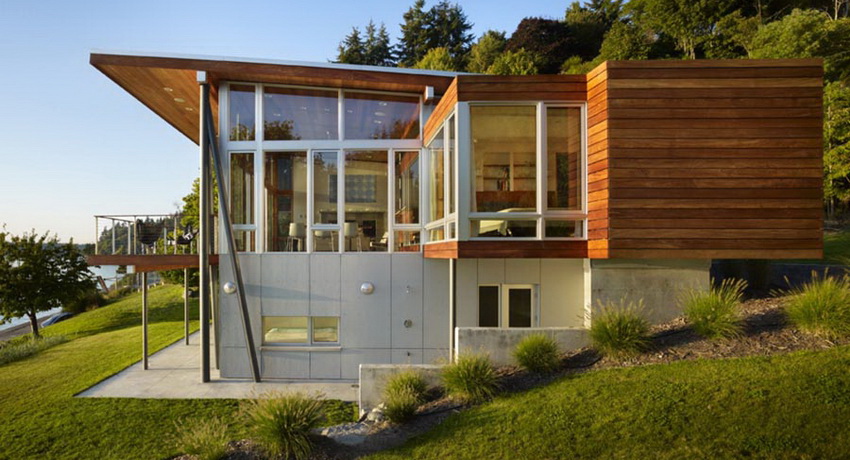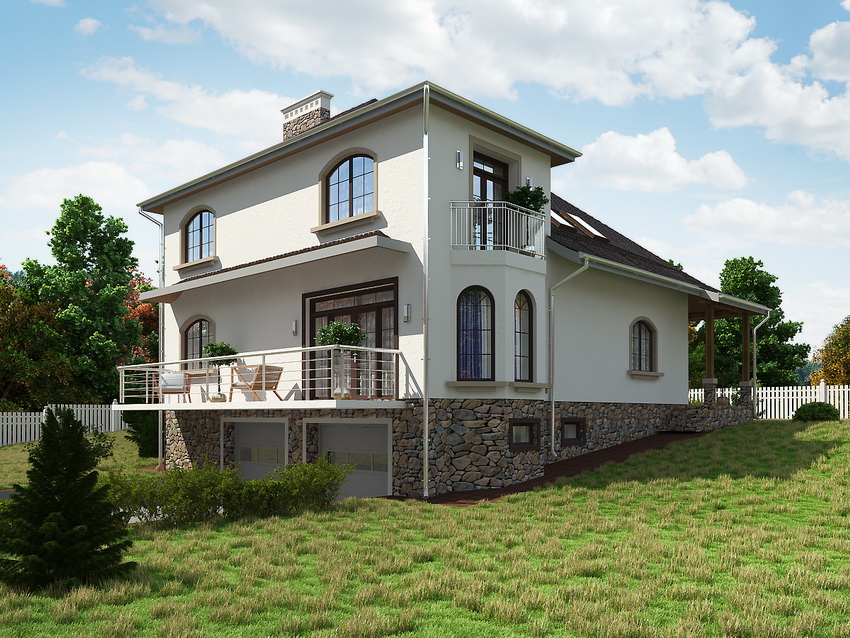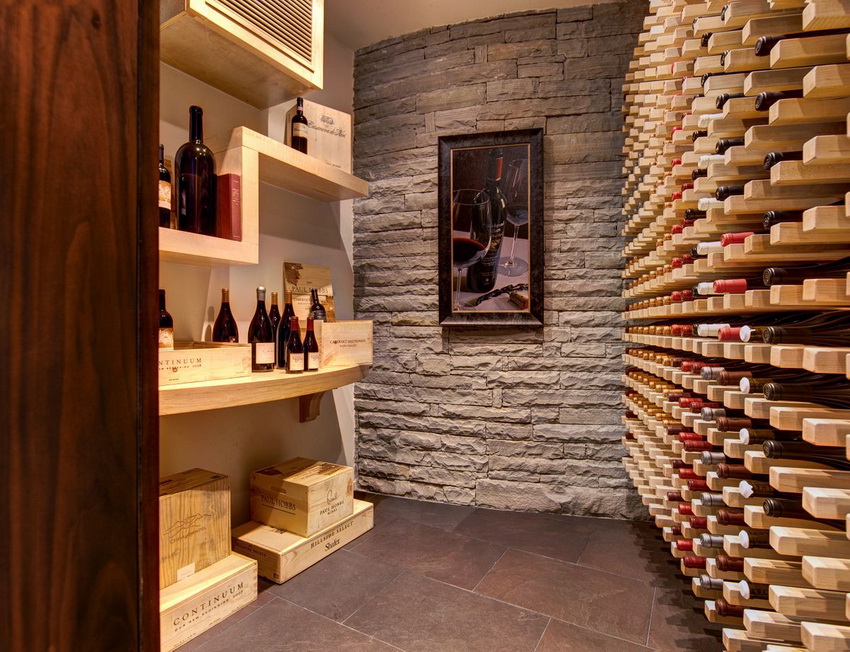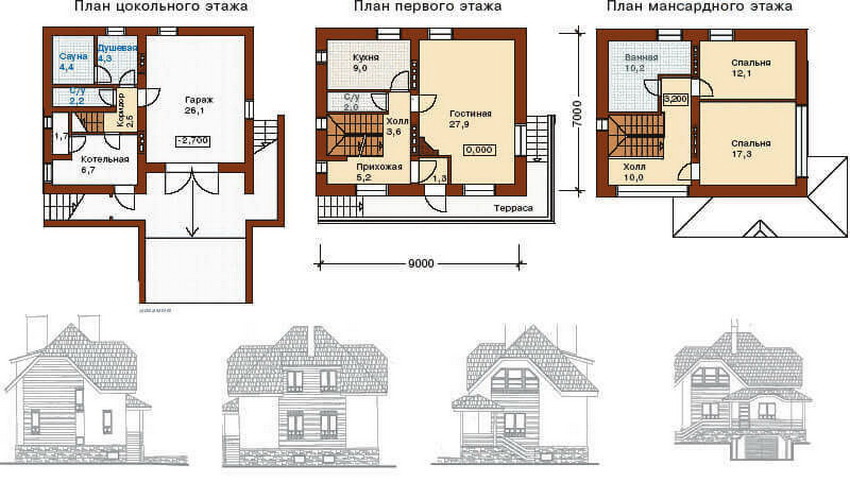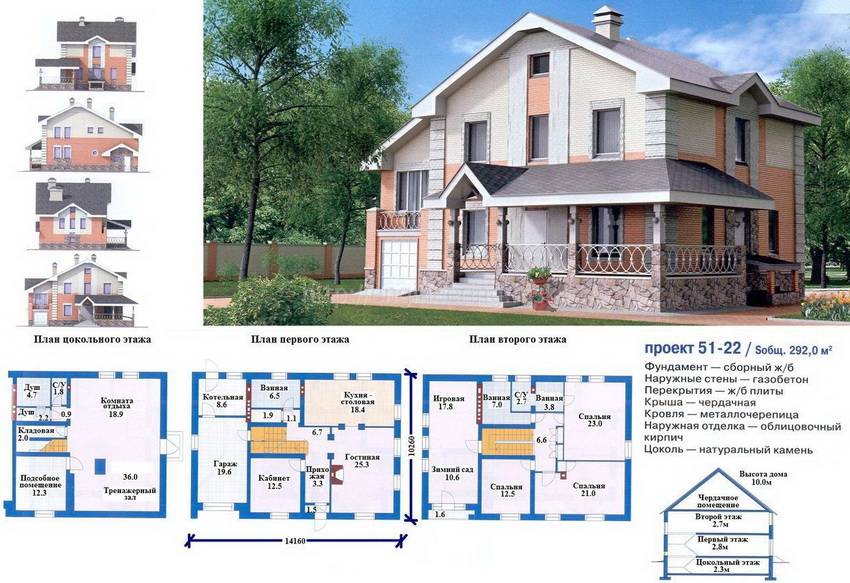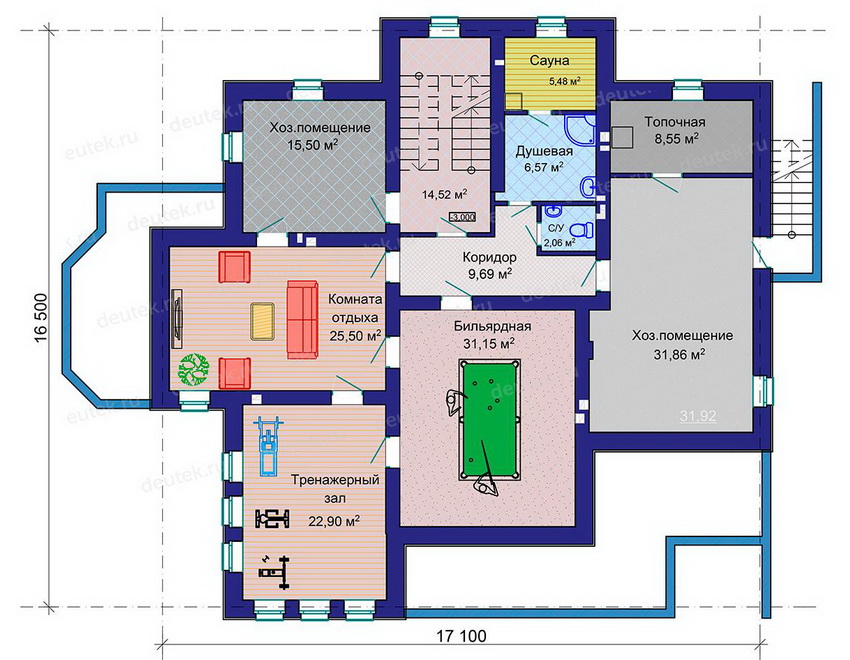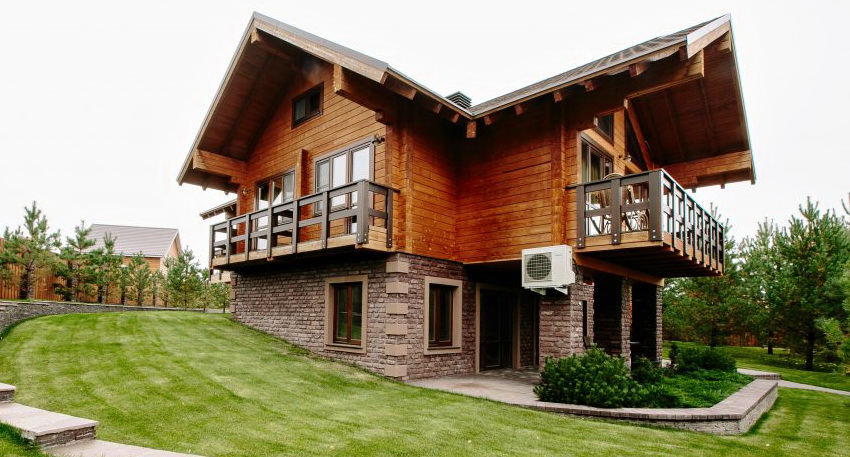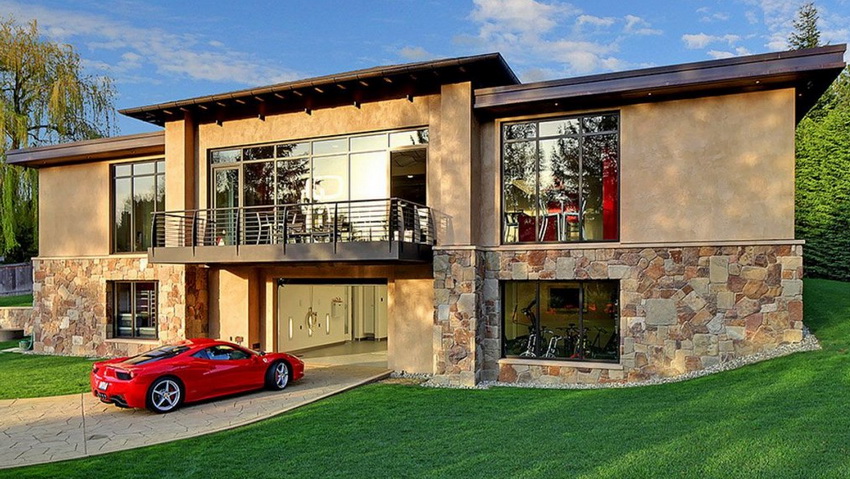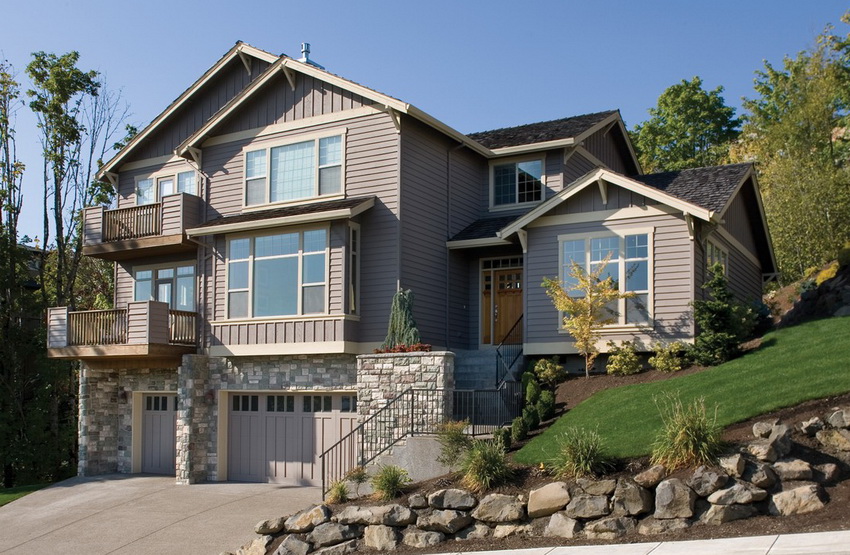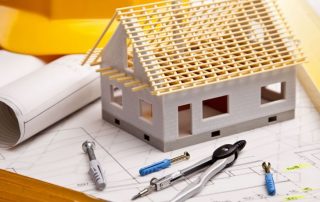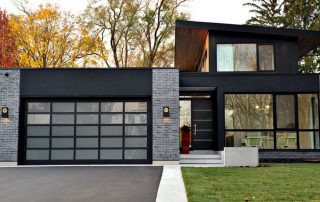The construction of any facility begins with design. This is a difficult and crucial stage, on which the strength, reliability of the structure, as well as the comfort of its inhabitants, will largely depend. The design of the living space should be as convenient, compact and ergonomic as possible, especially if construction is planned on a small plot of land. The projects of houses with a basement, described in the article, will help solve this problem.
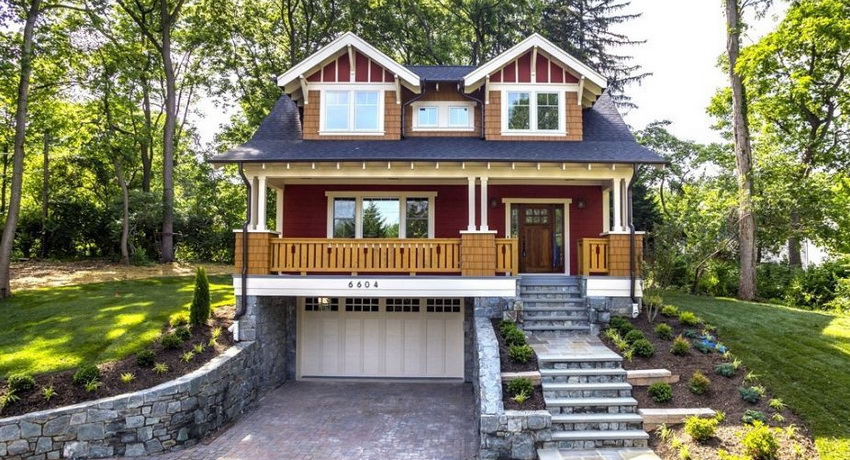
Usually house projects with a basement floor is used in small areas or to increase the living area of a small house
Content [Hide]
Projects of one-story houses with a basement: features and benefits
The design of residential buildings is not only the square and the size of the area of the rooms, but also the determination of the general structure of the future building. The presence of a basement or basement floor, as well as their absence, should be provided for by the project. After all, the building itself includes the aboveground and underground parts. The basement floor is located below ground level and reaches a maximum height of 160 cm, which is almost half the size of a normal floor.
The presence of a basement in a private home adds a useful living space that is equal in size to the entire house. This advantage allows you to more efficiently use the area around the house and save on the construction of utility rooms. Thus, in a house of 10x10 m, another 100 m2 of usable area is bonus.
Another positive factor is that the basement floor serves as a rational solution in homes located on areas with large slopes. In this version, the minus of the relief turns into a plus. A basement room that is completely above the ground on at least one side can serve as an excellent place to place an entrance to a house. The basement floor is a way out of a situation where, for various reasons, the construction of additional floors is not allowed.
Useful advice! To simplify the work in choosing a future home, taking into account all the taste characteristics of the owners, ready-made projects of houses with a basement will help. There are many photo examples on the Internet.
The purpose of the basement floor: photo examples of options
Another advantage of a house with a basement is its intended purpose. It can serve to accommodate not only living rooms, but also utility rooms. In modern construction, the design of recreation areas has become especially popular. Most often, the basement room is used to accommodate:
- garage;
- workshops for various purposes;
- boiler room;
- laundry;
- communication networks;
- gym;
- saunas or baths;
- pool;
- rooms for billiards and other entertainments;
- home theater.
Less often, in the project of a house with a basement, a kitchen or a bathroom is placed on the lower floor. Quite often, such a room is used to store garden and garden tools, various seasonal items, for example, intended for hiking and fishing. At a stable average temperature of +15 ° C, food, preservation, fresh vegetables can be well stored here. Wealthy owners often place wine cellars here.
The number of rooms on the basement floor may vary and may not always be the same as on the main floor. Also, there may be several utility rooms at once, for example, a garage and a workshop or a sauna with a swimming pool.
Experts recommend drawing up projects of houses with a basement in specific cases:
- on a slope or in an elevated area;
- in small household plots;
- if there is no other possibility of placing a garage or basement for storing vegetables and pickles.
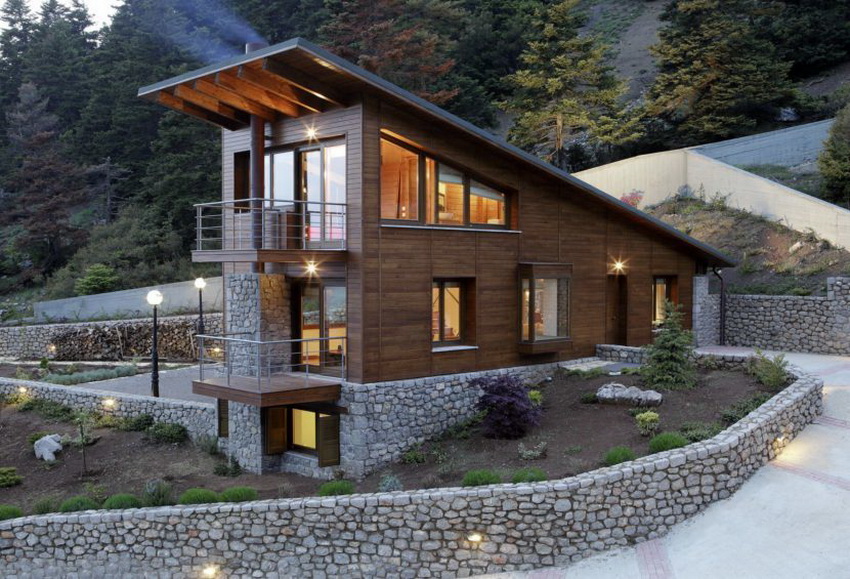
House projects with a basement floor are becoming more and more popular in modern construction
House projects with a plinth: pros and cons
Before making a final decision on the construction of a residential building and the advisability of placing a basement, you should take into account both a number of positive and negative factors. The advantages of such a structure include:
- the appearance of additional usable space without capturing the local area;
- the presence of utility rooms relieves the main part of the house, making it more spacious;
- due to the presence of the basement floor, the issue of additional floor insulation on the first floor is removed.
- the total usable area of the house, in particular the residential one, doubles if it is a project of a one-story house with a basement floor, and one and a half times if the house is two-story;
- life becomes more comfortable if the living quarters and utility rooms are under the same roof;
- saving money on the construction of additional buildings in the yard;
- no problem with laying communication networks.
Important! Experienced builders are not advised to include in the project a basement in an area where there are flooding by melt, rain or groundwater. In order to ensure the normal operation of the premises, it is necessary to take care of the installation of a special drainage system, which can cause additional serious costs.
Despite the long list of positive aspects, a number of disadvantages associated with the presence of a basement room in the building should also be noted. These include:
- a significant amount of earthwork and the need for soil removal;
- in such construction, one cannot do without the involvement of special equipment, especially if it becomes necessary to erect a basement floor from blocks or concrete slabs;
- requirements for waterproofing in a semi-basement are increasing, it is necessary to think over and ensure the construction of a blind area and a drainage system;
- the increase in costs is also associated with the consumption of additional electricity to illuminate the underground part of the house.
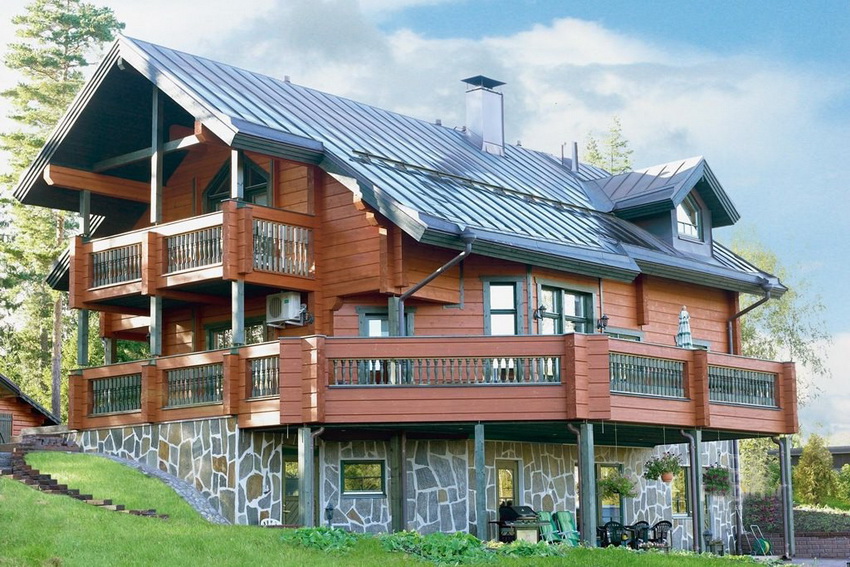
The arrangement of the basement floor requires a careful approach and therefore the cost of the entire building increases
Preparation of projects of houses with a basement and a garage, other premises
Even before creating a project, you need to carefully consider all the nuances, take into account a number of features and thoroughly approach the construction of a house with a basement or basement. The determining factor is the type of soil on which the building is planned to be erected.
It is difficult to build objects below ground level on rocky or sandy ground. Difficulties will also arise when the soil is saturated with groundwater. In some cases, the idea of building even a one-story house with a basement should be abandoned altogether. Ideally, for this type of construction, sands and groundwater should lie at a depth of over 1.5 m. Otherwise, one cannot do without the advice of highly qualified specialists.
Even before the start of work, the builders necessarily carry out a number of geodetic measures, including the study of the terrain and determining the depth of the aquifer. If the groundwater is above the specified level, then the construction of the basement is not excluded, but becomes more voluminous and costly, which is associated with the creation of reliable waterproofing protection. In this case, it is easier to order the construction of a turnkey basement, taking into account the conduct of geodetic research and design.
Do-it-yourself basement floor construction: features and nuances
These factors usually take into account the finished projects of residential buildings with a basement. If you strictly follow the recommendations specified in the project documentation, then it is even possible to erect the base yourself.
Structurally, the construction of a basement floor is very similar to the process of making a foundation, which includes 2 stages:
- preparation of the tape sole. It is placed approximately 20 cm below the level of the future floor;
- building walls. There are several ways, but the most popular is the use of foundation blocks.
Useful advice! Ordering the development of project documentation or buying a finished project should be in companies specializing in their creation, whose activities are time-tested. It is the firm that is fully responsible for the developed documentation. Reliable partners will ensure not only the reliability and quality of the building, but also the comfort of living, as well as the efficiency of work.
In addition to the above factors, experienced specialists carry out an adaptation check of the building for compliance with certain conditions, taking into account the fact that an ordinary basement or basement in a private house differs from the basement in the level of deepening. The floor in a building with a plinth goes underground by 1/3 of the floor height, and with a basement - by 2/3 or even lower. It should also be noted that the construction of the basement floor provides for the presence of windows that must be placed above the ground.
An important factor in the construction of buildings with a plinth is its waterproofing. In this matter, savings are unacceptable, and even more so neglect, since being in damp rooms is not only uncomfortable, but also very unhealthy. All of the above nuances should be taken into account even at the planning stage (they are usually taken into account by architects when creating projects).

For the arrangement of the basement floor, it is recommended to choose an area without a close location of groundwater
Projects of houses with a basement: types and their differences
There are many options for building houses with a basement. Its absence or presence, the materials used, the number of floors and rooms are the main components of the price of general construction. Thus, the following factors affect the cost of building a residential building:
- the number of floors expected;
- total area of the building;
- topography, soil composition and depth of groundwater;
- the volume of earth and concrete work;
- construction of a drainage system and ventilation in order to create a healthy microclimate;
- the complexity of the project.
Related article:
Projects of houses with an attic and a garage: various variations of buildings
Distinctive features of buildings. Key points when designing. The choice of material and type of roof. Options for projects of houses.
The entire construction process begins with the construction of the basement. Particular attention is paid to it, since the condition of the entire building will depend on the quality and strength of the base. It is he who will hold the weight of the entire main building.
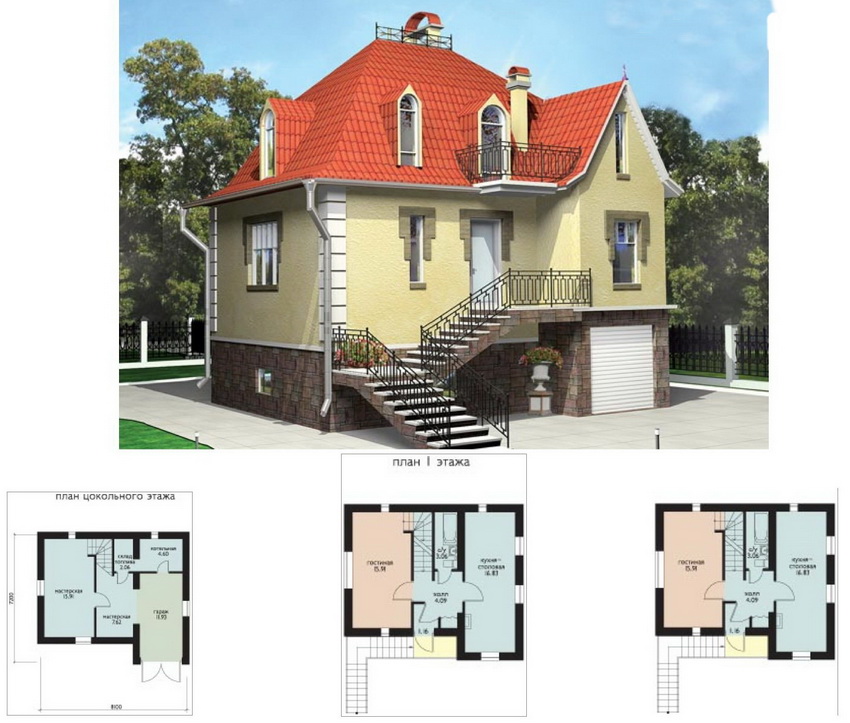
The basement floor is the most important as it also serves as the foundation that holds the entire building
It should be noted that the material of manufacture affects the cost of construction work. For the construction of basements, the same materials are usually used as for creating a conventional foundation for a house with a basement. These are bricks, slabs of expanded clay concrete, gas or foam blocks. You cannot do without logs and beams. The cost of a typical project may increase subject to a number of changes.
Typical projects of houses with a basement floor constitute a separate category, ranging from projects of houses with a basement, one-story, two-story buildings, with or without a garage, to complex drawings of houses with an attic.
One-storey houses with a basement
Such a construction is a way out of the situation when you need to save money on the construction site, but increase the usable area of housing. In houses of this type, a varied arrangement of rooms and utility rooms is permissible. If a country cottage is being built, then they use a simple technology of a recessed foundation of a reinforced structure.
Important! There are no standard house designs on slopes and hilly surfaces. They are compiled individually, taking into account the features of the relief and the size of the construction site.
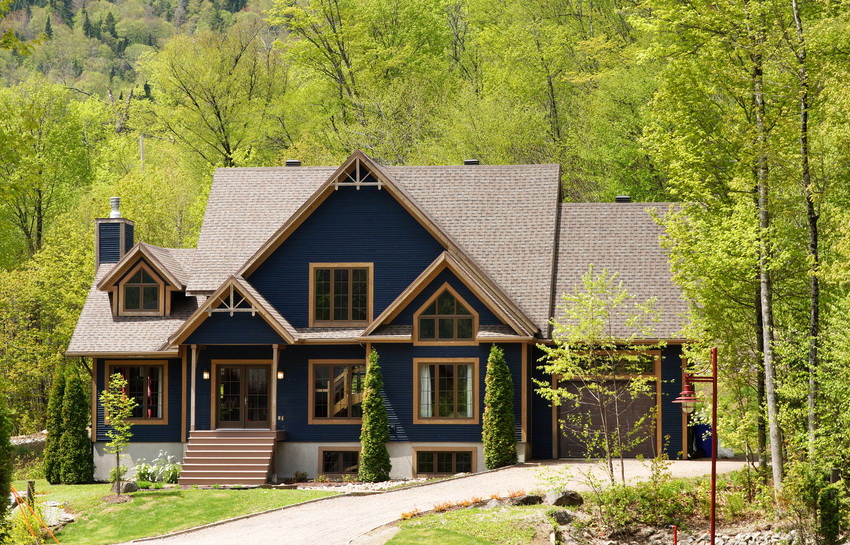
Each project of a house with a basement floor is developed individually based on the characteristics of the site
In this case, a tape or monolithic base is used, but they require certain physical and financial costs associated with earth and concrete work. Thus, the construction of a foundation with a plinth will make up one fifth of the cost of the entire construction.
The underground part in simple projects of one-story houses with a basement is (relative to the location of the rooms) a repetition of the scheme of the main room. In more complex structures, the layout can change significantly. The maximum deepening of half a floor has practically no effect on the increase in the overall height of the building. Country cottages with deepened foundations look very solid. Small houses with an attic have a particularly attractive and neat appearance.
The facing material gives the houses a special sophistication. To do this, use decorative plaster, clinker, polymer sand tiles, artificial stone and other finishing materials for outdoor work. One-storey buildings with a basement and three living rooms are ideal for a family of three. With a total area of 150 m², the number of household members can be much larger. Typical designs and drawings of one-story houses can be found on the Internet.
House project with basement and garage
A small cottage with a garage in the basement is the choice of people seeking convenience, economy and comfort. Additional advantages of such a building are that you do not need to go outside to enter the garage. The temperature regime in the basement, even without heating, is usually much higher than in conventional garages, which contributes to better vehicle safety.
It should be noted that experienced designers in terms of practicality give preference to houses with an attached garage, above which there are no other premises. This option also helps to save space and building materials.
Build an ordinary basement in a private house with your own hands is a possible process, taking into account all the design features. The construction of a garage in the basement is a more difficult task that requires taking into account such criteria:
- thorough geodetic survey of the soil. To locate a garage in the underground part, the close location of both groundwater and open water bodies is unacceptable;
- competent design and installation of the ventilation system;
- convenient communication between the basement and the main building;
- additional external insulation, waterproofing and lighting of the building.
Useful advice! When designing a house with a built-in or attached garage, it is necessary to ensure high-quality ventilation in the room and prevent exhaust gases from entering the living quarters. Good thermal insulation of the premises during construction from foam blocks will be provided by the technology of two-row masonry.
Projects of two-storey houses with a basement
A simple way to increase the area of a residential building is to build an additional floor. Therefore, projects of a two-story house with a basement are the most popular and convenient options for living. The presence of a garage makes it easier to use the vehicles. After all, there is no need to go in the snow and rain behind the car - you just have to go down to the basement.
Typical drawings of two-story houses take into account the traditional requirements of the owners. For example, a house with a basement has an area of 11.5 × 12 m. In this case, the length and width can be shortened to obtain a building measuring 110 or 100 m². The total area of the building will be about 190 m². Living area - approximately 70 m².
The most common building material is thermal panels (or clinker). The basis is a strip or monolithic foundation. Retaining and basement walls are made of gas silicate blocks. Internal walls are made of gas silicate blocks with a reinforced reinforcing frame.
Speaking of two-storey buildings, it should be noted their advantage in saving territory. The building can be placed even on a small or narrow plot of land, respectively, the length of communications is reduced. In addition to the above, it is worth noting that two-story houses warm up quickly. Projects of houses with a basement and an attic contribute to heat conservation from below and from above.
Features of projects of houses with an attic and a basement
The attic automatically turns a two-story house into a three-story one without violating the law prohibiting the construction of private houses above two stories. There are many home projects with a basement and an attic. They are easy to find on the internet.
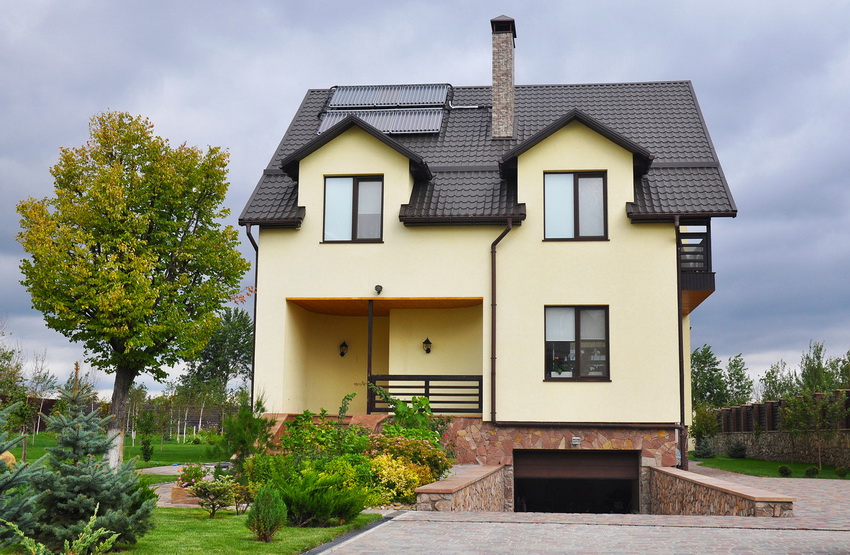
Attic and ground floor automatically convert a one-story house to a three-story house without increasing taxes
The main difference between a house with an attic and a three-story cottage is the significantly lower construction cost. This is an important factor for developers who want to save on materials. An ergonomic option is projects where the staircase takes up a minimum of usable space. The buildings with balconies on the attic floor look original. The main advantage is an increase in the usable area by a third. This is a great place to place a seating area and a living room.
A semi-basement room makes the house more convenient and functional, which leads to increased convenience and comfort under one roof. The presence of an attic not only complements the useful area of the building, but also serves as a thermal insulation layer for the main floors. The numerous advantages and benefits of houses with a basement, listed in the article, make such structures especially popular, and projects are in demand among architects.
